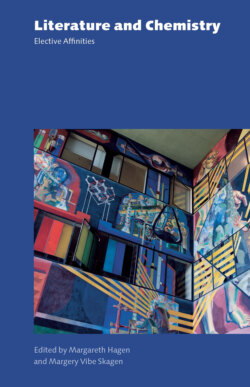Читать книгу Literature and Chemistry - Группа авторов - Страница 13
На сайте Литреса книга снята с продажи.
LITERATURE, CHEMISTRY, AND THE SUBLIME
ОглавлениеIntroducing the anthology Literature and Science, Sharon Ruston reminds us of yet another important connection between the two cultures, the sense of wonder at the natural world: “The idea that one can find the miraculous or the wonderful in the material and the everyday is something both literature and science have claimed for themselves at different times” (Ruston, p. 6). As several science writers mentioned by Ruston have argued, scientific knowledge of the natural world may serve to reinvest this world with value, meaning, and enchantment.18
Chemistry means focusing on what the world is made of, and the eternal, undiscriminating circulation of the elements, atoms, and sub-stances. Fascination with matter is a recurring theme when literature encounters chemistry, and the chemical etymologies of sublimation and the sublime are not forgotten. Science, however, is not the domain of rapture and fury; the rhetoric of science is not consistent with hyperbole, or with the “inaccurate and vague state of perception” and the broken, obscure language “wild with metaphor” Ruskin associates with true inspiration (Ruskin, p. 209). The rhetorical sublime is of little relevance to the author of a scientific article whose purpose is to communicate emotionally flat, paraphrasable knowledge. Primo Levi typically plays down pathos in his writing, which privileges lucidity and precision; his is a style inspired by practical chemistry. All the more remarkable is how Levi expresses emotions and feelings of wonder and beauty when describing the world of chemistry. According to Roald Hoffmann, the practice of science usually leads away from awe. Speaking on behalf of chemistry in his article “On the Sublime in Science”, he claims:
“Sublimatio” (Hieronimus Reussner, Pandora, das ist die edleste Gab Gottes oder der werde und heilsamme Stein der Weisen. Basel, 1582).
We do not have the very small of elementary particles or the soaring large of galaxies. Chemistry lacks that easy ladder to the sublime of boundlessness, of the downward or outward freeways to infinity. (Hoffmann, p. 150)
The layman or woman would not always agree. The idea that the same molecular structures that constitute the chemical building blocks of our living brains and bodies are to be found in the remotest nebulae of the cosmos is a source of fright and fascination. Just thinking about the conjunction of the universal and the particular, or the macro- and microscopic avenues underlying vast and small material phenomena, is enough to overwhelm most imaginations. The chemical and alchemical sublime is not absent from the literary examples presented in this volume. And for Hoffmann too, chemistry has its wonders. In his article he points to functional aspects of chemistry that touch upon the sublime, some of which are metaphorically transferable to our context of literary creation and scholarship. As seen in the chemical process of sublimation, in which a solid is transformed into gas and then back to a solid, change is “the defining essence of chemistry” (p. 152).19 The chemical object’s potential for change is an aspect of the dynamic sublime (p. 154).20 Furthermore, Hoffmann recognises a “median sublime” in “the living middle of human beings and molecules in equilibrium”, in the captured energy “suspended in a multidimensional space defined by crisscrossing polarities”, with its potential for reaction in one direction or the other. In our context of chemical and literary affinities, we note that the precarious state of balance between opposing forces, which some slight but decisive perturbation will release, is also an infinite source of narrative if we follow the basic schema of classical structuralism: when action is sparked off by some initial provocation and the characters are compelled to respond to the consequential trials and choices of the complication until the dilemmas are resolved through processes of separation and reconnection, allowing a new state of equilibrium to emerge, awaiting new narratives of transformation in turn.
Chemical discovery and invention by way of experiment and theory is a continuous cause of the astonishment of novelty, touching upon the sublime of infinite variability. As the emphasis has shifted from analysis – the aim of understanding the mysteries of matter by separation – to synthesis and the creation of millions of new compounds, chemistry’s capacity to transform the natural world for better or worse nourishes the public’s admiration and concern.
Hoffmann’s considerations of chemistry’s transformational power is here a reminder of imaginative literature’s alleged power to form and transform readers: building or corrupting their characters, edifying them, enlarging, refining, or polluting their minds. Like its ancestor alchemy, chemistry has always had a darker and decidedly troubling side, infected with the guilt of hubris, with artifice and contamination, faults that, since Plato, have also been associated with literature. Chemistry is associated with humankind’s apparently boundless powers of destruction and creation, for most of us beyond control or comprehension, with its capacity to produce lasting changes in the world’s atmosphere or in the climates of our minds. Whether salubrious or intoxicating, literature and chemistry’s potential to build and dissolve, consolidate and transcend material and immaterial life is dependent on the large community of authors and readers transcending temporal and spatial as well as cultural and disciplinary barriers. The present volume is dedicated to this communication.
In this spirit of affinity, the sixteen authors of this anthology break new ground in demonstrating chemistry’s particular status as one of the sciences in which the humanities should interest itself, the overlaps and reciprocities of the two fields, and – perhaps most importantly – chemistry’s role in the production of narrative, metaphor, and literary form. This volume makes the silent presence of chemistry everywhere more perceptible, uncovering its historical and present appeal to material sensitivity, imagination, and creativity, as well as its call for philosophical and ethical concern, and for wonder.
Bergen, November 2013
Margareth Hagen and Margery Vibe Skagen
